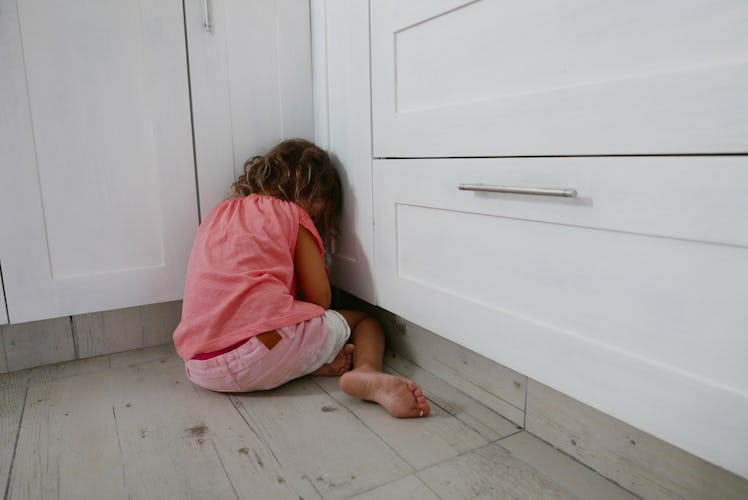You’re Probably Doing Timeouts Wrong
Timeouts may seem like the perfect solution for child discipline problems, but they’re rarely used correctly, which makes them less than useful.

The timeout discipline strategy has been around since the mid-1950s when it was conceived of as a way to remove a kid’s access to fun as a form of mild punishment. Over the following 60-plus years, the form and duration of the recommended timeout have been modified based on studies and expert opinions, popularized by British nannies on television, and challenged by proponents of the positive parenting movement. But at its core, the timeout remains the same. It’s about asking a child to course-correct.
Although the core advice for timeouts remains fairly consistent among experts, parents often go rogue. Anger, lecturing, yelling, excessive time, and a lack of reconciliation at the end of the timeout can all derail the method’s efficacy. The harsh truth is that timeouts can work, but many parents are doing them wrong.
Harsh Truth #1: Timeouts Don’t Work During Meltdowns
Many parents don’t feel their discipline is working until a kid is crying fat, devastated tears. That’s a problem.
The point of a timeout is both removing the kid from the stimulus and helping them reflect on the choices they made that put them in timeout. When a kid is melting down or overly emotional, they are both overstimulated and unable to process what’s happened.
Timeouts are best accomplished when everyone is calm — not only the kid, but the parent too. A child should be placed in timeout when they are relatively calm, and they should be able to give an explanation of why they are there. If they believe they’re on the naughty step just because a parent is pissed, they’re not learning anything aside from why they should avoid parental anger. That’s no way to teach morality. And making good moral decisions is the whole point of discipline.
Harsh Trust #2: Timeouts Aren’t About Banishment
Many parents believe that the whole purpose of a timeout is to remove misbehaving kids to a place where no one has to deal with them. But banishment isn’t the point. A child engaging in antisocial behavior isn’t helped by being socially ostracized from the family. The better technique is to keep them close. That means that when parents engage in timeouts, they should keep their child in a social place, but encourage them to stay reflective and quiet. Kids need to continue to feel as if they are part of the family instead of doubling down on the idea that they’ve behaved so badly they shouldn’t be seen.
After all, sending a misbehaving kid somewhere else is often less about helping the kid than it is about giving the parent some space. And, sure, parents sometimes need space. That need confuses the point of discipline, which is to help a kid develop an understanding of how to make prosocial choices in the face of adversity.
Harsh Truth #3: Parents Should Get Timeouts Too
Timeouts, when done properly, can help a child learn to regulate their emotions. But that becomes far more difficult when the parent putting them in timeout is modeling poor management of their own emotions. That’s where the parental timeout comes in.
Discipline is always best served with a helping of calm care. This is wildly important because children learn to behave primarily by observing parents. A parent who can step away for a moment and take some deep calming breaths will have a child who learns to do the same. A parent that escalates and reacts with anger will also have a child that does the same. So, before giving a child a timeout, it might help if the parent takes one first.
Harsh Truth #4: Timeouts Don’t Work on Their Own
A timeout — that is, sending a kid away until a timer rings and then letting them off the hook — will not be effective if that’s all a parent does. The physical act of taking the timeout is just a small portion of the overall process.
The process of a timeout should also include some light, age-appropriate discussion. This should include an explanation of why the timeout is happening and an exploration of what the better behavioral choices might have been. But even after that talk, parents should consider whether there will be additional natural consequences so a kid can make reparations. Those reparations can include everything from an apology to cleaning up a mess.
Harsh Truth #5: Timeout Should End With Love
The harshest thing about this timeout truth is that parents often might not feel like making up with their kid after a timeout. But that simply a way to foster never-ending parental grudges, which are unhealthy for everyone.
A timeout should always end with a kiss or a hug and a reassurance that the child is still very much loved. It’s too easy for kids to internalize feeling like a bad person. Just because a timeout isn’t as physically rough as spanking doesn’t mean it isn’t psychologically tough. That’s why parents need to end the discipline with a reassurance of their complete and unconditional love.
This article was originally published on